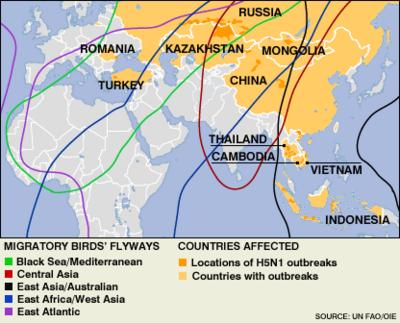

Agricultural Minister Elena Espinosa of Spain, during a radio broadcast on Cadena Ser (attributed to Agence France-Presse), said the H5N1 strain of the avia flu is “solely and exclusively a veterinary problem.”
Espinosa said “The idea of a pandemic among humans is something from science fiction.” Further, she said human infections currently in Asia were “in very specific poultry raising situations where the families lived with the chickens and infection was due to constant inhalation.”
Is this not the nation that, following the Al Queda attack on March 12, 2004, elected an administration that folded its tent in Iraq and assumed the fetal position when confronted by terrorists? I suppose that’s a nice way of saying I’m “considering the source.”
In the real world, the strain of H5N1 has been documented and specifically linked to the deaths of 60 persons in Asia in the past three years. Scientists say that, though the strain does not yet spread easily from person to person, the possibility exists that it could mutate into a variety that could be spread as easily as any seasonal flu.
CDC Director Julie Gerberding said “If ever there was a time when the risk (of a pandemic) was higher than usual, it is now.”
World Health Organization Regional Director for the Western Pacific, Shigeru Omi, said that with one small genetic adjustment in Influenza A, or H5N1, millions of people across the planet could die on a scale of the 1918 flu pandemic. Public health officials from the Western Pacific region recently gathered at Noumea, New Caledonia, on September 19th, to discuss the issue.
The worst-case scenario, the New York Times reported, would be if person-to-person transmission spawned successive generations of severe disease with high mortality – the situation during the great influenza pandemic of 1918-1919, which killed an estimated 40 to 50 million people.
The early 20th century disaster resulted from the emergence of a completely new influenza virus subtype that spread worldwide in four to six months, causing several waves of infection over two years.
The H5N1 virus, which spreads through migratory birds, has plagued poultry populations in Asia since 2003, exposing more humans.
Several nations in Europe and Asia are now reporting new cases of the lethal H5N1 bird flu strain among poultry, sparking new fears that humans could be at risk. Fresh outbreaks have been reported in Romania and Russia. China says it has lost thousands of fowl to the virus.
More on this in later posts.

